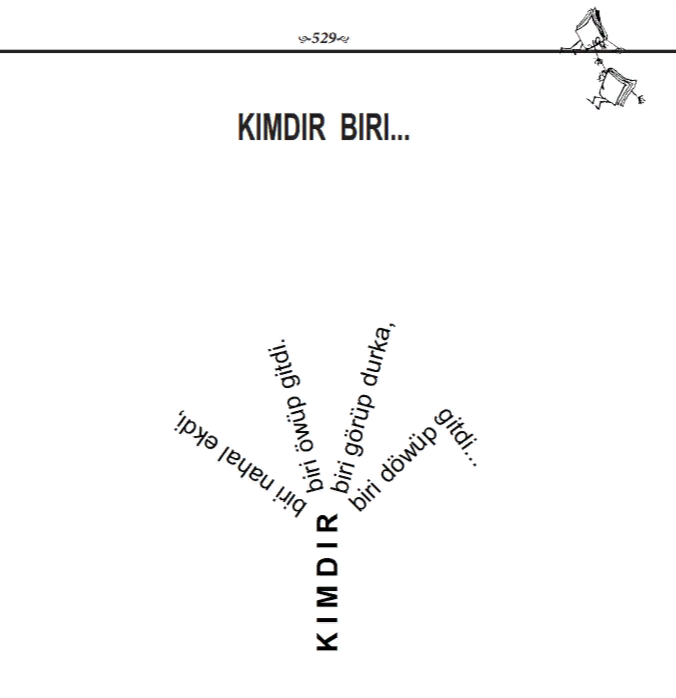Contrary to the popular belief that graphic poetry or visual verse does not carry a major artistic task, the work of the famous Turkmen writer, poet and playwright Hemra Shirov proves the opposite.
Having become interested in this literary genre in the mid-1990s, he became the founder of graphic poetry in Turkmen literature, actively developing it and filling it with new meanings.
The unusualness of the genre is that the words in a visual or, as it is also called, graphic poem form a picture, which is designed to support the content with its form.
Shirov's visual poems are based on his firm principles of kindness and justice, faith in the goodness and confidence that victory is always on the creative side.
Using examples of some poems, I invite you to take a short journey into the world of Hemra Shirov’s graphic poetry.
In the poem called Säher “Morning” we can not only read the words of the poem, but also see the Sun rising over the city.

Her säher ýalbyrap doganynda gün,
Çar tarap ýagtylyp umma gaçýar tün.
***
“Every morning when the shining Sun is born.
In all directions dissipates the night”.
The lines here are arranged to create an image of the rays of the rising Sun, which represents the author's belief that light overcomes darkness and his hope that every day people have the opportunity to do something good.
And, here we have the poem Gumsagat “Hourglass” with a philosophical “filling”.

Wagtyň gadyrlygyny bilmegi, juda tygşytly bolmagy duýdyryp akyp dursun.
***
“Let this flow remind us how it is difficult to value the time”.
The poetic line creates the outline of an hourglass and contains a simple, but at the same time, difficult to understand conclusion: time passes irrevocably, and human life is not endless. To have time to do something worthwhile, you need to be able to use every second of your life. Many of us are often overwhelmed by laziness to do something, test ourselves, learn something new, pass on what we know to other people. We think: “We have our whole life ahead of us, so we still have time...Here, let’s scroll through our feed on social networks, and then we’ll start...”. However, the poet offers us to think about hourglass as a symbol of the transience of time; it is a clear example for those who never started, continued or completed. Man is not eternal, but his deeds can become immortal. The main task is to find time to leave behind a creative mark.
The graphic poetry of Hemra Shirov is not for the chosen ones, no. It is for everyone, as it touches the feelings and aspirations of every person, be it a child or an adult. The poet uses visual verse as a direct way of communication - without intermediaries.
For example, the poem Ýeniş Güni “Victory Day” depicts a carnation flower, and also, if you look closely - festive fireworks in a peaceful sky.

Every year we lay bouquets of flowers on Victory Day at the memorial to those who fell in the Great Patriotic War.
Gurban bolan gerçekleriň guburyna goýyas güli, rahat ýatyň!
Gutly bolsun ýeňiş güni! ýeňiş güni! ýeňiş güni!...
***
«We bring flowers to the memorial of the fallen, rest in peace, warriors!
Happy Victory Day! Victory Day! Victory Day!...»
We see how the petals of a flower rise upward with the phrase Ýeňiş Güni (“Victory Day”), which has been close to everyone since childhood. The poem is good to read with children, and while they “collect” the words into a single line, the pictures of our childhood come to life in our memory, when on May 9, we walked with our parents, and flowers were always in our hands. Mom always cried on this day, remembering her uncles who disappeared in the war. The veterans stood at the Quenchless Flame, mournfully lowering their heads. Over the years, we have seen that there are fewer and fewer of them, but this does not diminish the memory... That's what this poem is about - about our memory, in which the brightest moments of this national day - Victory Day - have been preserved.
Another wonderful example of Hemra Shirov’s verse is the visual verse Kimdir Biri “Someone”. It is created in the form of a tree with one broken branch.

Words stretch along each branch, and their meaning is as follows:
Kimdir biri nahal ekdi,
Kimdir biri öwüp gitdi.
Kimdir biri görüp durka,
Kimdir biri döwüp gitdi...
***
«Someone planted a tree
Someone praised him for this.
Someone standing and watching,
Someone else broke a branch…»
A drawing of a tree with intact and fluffy branches looks harmonious, but with a broken branch, it looks defective... The author expresses this life observation very succinctly: for every person who plants a tree, there is “someone” who breaks it. What should I do? Vicious circle? Perhaps the author with this poem invites the reader to tear this vicious circle up and stand on the bright side of the “tree planters,” as well as those who encourage and inspire them. He also asks those who break and watch indifferently to think...
Figured verse seems simple only at first glance. However, if you take a closer look, it is not so simple, having a great potential for semantic load – it is emotional, philosophical and problematic.
Having an excellent taste for words, Hemra Shirov skillfully uses the tool of visualization of poetry to highlight certain life themes, inviting the reader to think through, speculate and find their way in a life illuminated by the Sun.
Visual poems by H. Shirov were published in the 2011 issues of the Turkmen Dili newspaper (March 2, March 30, April 27) and the Nesil newspaper for 2008, December 18.
Author is Maral Hydyrova.
Translated from Russian by Serdar Shirov.

